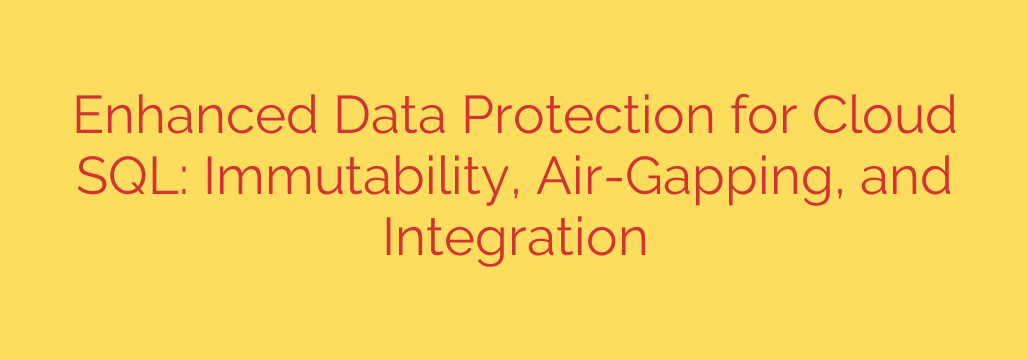
Fortify Your Cloud SQL: Advanced Strategies for Ransomware-Proof Data Protection
In today’s digital landscape, the security of your cloud databases isn’t just an IT concern—it’s a core business imperative. With the rising sophistication of cybersecurity threats, especially ransomware, traditional backup methods are no longer sufficient. Attackers now actively target backup files, seeking to encrypt or delete them to remove any chance of recovery and force a payout.
To truly protect your critical data in Cloud SQL and similar managed database services, you must adopt a multi-layered defense strategy. This approach moves beyond simple recovery points to create a resilient, tamper-proof system. The key pillars of this modern data protection strategy are immutability, logical air-gapping, and seamless security integration.
The Unbreakable Shield: Why Immutable Backups are Non-Negotiable
The first line of defense against an attacker who has breached your network is an immutable backup. But what does that mean?
In simple terms, immutability makes your backup data unchangeable. Once a backup is created and marked as immutable, it cannot be altered, encrypted, or deleted by anyone—not even an administrator with the highest level of privileges—for a predefined retention period.
This creates a powerful safeguard against ransomware. If an attacker gains access to your systems, they might be able to encrypt your live production database. However, they will be powerless to touch your immutable backups.
Key benefits of immutable backups include:
- Guaranteed Recoverability: You always have a clean, uncorrupted copy of your data to restore from, neutralizing the threat of ransomware.
- Protection Against Malicious Insiders: The policy prevents accidental or intentional deletion of critical data from within the organization.
- Regulatory Compliance: Many industry regulations require data to be stored in a non-erasable and non-rewritable format, a standard that immutability helps you meet.
Security Tip: When configuring your backup policies, always enable immutability with a retention period that aligns with your business continuity and disaster recovery (BCDR) plan. This ensures your data is protected for a duration that makes sense for your operational needs.
Beyond the Firewall: The Modern Air Gap for Cloud Databases
The concept of an “air gap” traditionally referred to physically isolating a computer or network from all other networks. In the cloud, this principle is adapted into a logical air gap.
A logical air gap ensures that your backup data is stored in a separate, isolated location with independent access controls, making it invisible and inaccessible from your primary production environment. For a Cloud SQL instance, this could mean storing backups in a different cloud project or account with entirely separate credentials.
Here’s why a logical air gap is so effective:
- Breach Containment: If your primary production environment is compromised, the attacker has no pathway to the isolated backup location. The stolen credentials for your production database won’t work for your backup vault.
- Independent Security: The backup environment can have its own, more stringent security policies and monitoring, completely decoupled from the day-to-day traffic of the production network.
- Reduced Attack Surface: By separating backups, you drastically shrink the potential points of failure that an attacker can exploit.
Actionable Advice: Never use the same service accounts or user permissions for your production database and your backup storage. Create a dedicated, highly restricted set of credentials used exclusively for writing to and managing your backup repository.
Unified Defense: Integrating Backup Security into Your Operations
Advanced data protection isn’t a standalone task; it must be woven into your overall security framework. Storing immutable, air-gapped backups is a massive step, but you also need visibility into the health and security of your backup operations.
This is where integration comes in. Your data protection platform should feed critical alerts and events into your organization’s central security tools, such as a Security Information and Event Management (SIEM) system or a security command center.
Integrating your data protection platform with security tools like a SIEM provides a unified view of your entire security posture, enabling faster threat detection and response.
Consider these scenarios:
- Failed Backup Alerts: An unexpected backup failure could be an early indicator of a system issue or a malicious actor tampering with your environment. A SIEM can correlate this with other network events to flag a potential threat.
- Anomalous Access Attempts: Alerts on suspicious login attempts to your backup repository can signal a targeted attack, allowing your security team to respond before a breach occurs.
- Immutable Lock Monitoring: An alert triggered by an attempt to delete an immutable backup is a red flag for a serious, active threat within your network.
By centralizing these signals, you empower your security team to see the full picture and connect dots that would otherwise be missed.
Building a Resilient Data Strategy
Protecting your Cloud SQL data in the modern era requires a proactive, defense-in-depth mindset. Relying on basic backup and recovery is no longer enough.
By combining these three powerful techniques, you create a formidable defense:
- Immutable Backups ensure your recovery data is tamper-proof.
- Logical Air Gaps isolate your backups from a production environment breach.
- Security Integration provides the critical visibility needed to detect and respond to threats in real-time.
Implementing this trifecta of protection transforms your backup system from a simple recovery tool into a core component of your cybersecurity strategy, ensuring your organization can withstand and rapidly recover from even the most sophisticated attacks.
Source: https://cloud.google.com/blog/products/databases/introducing-enhanced-backups-for-cloud-sql/








